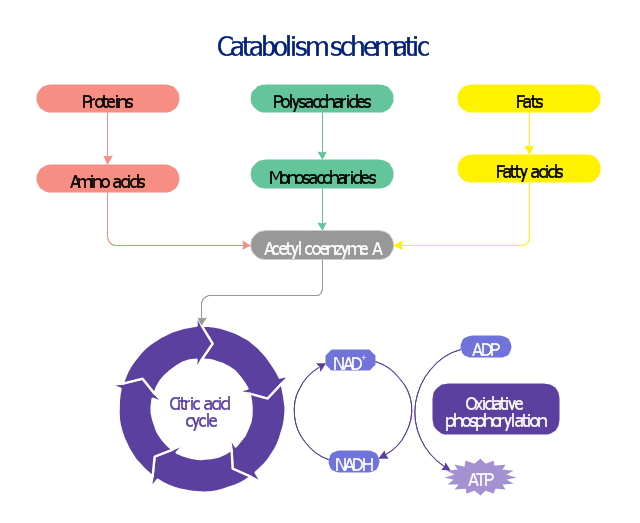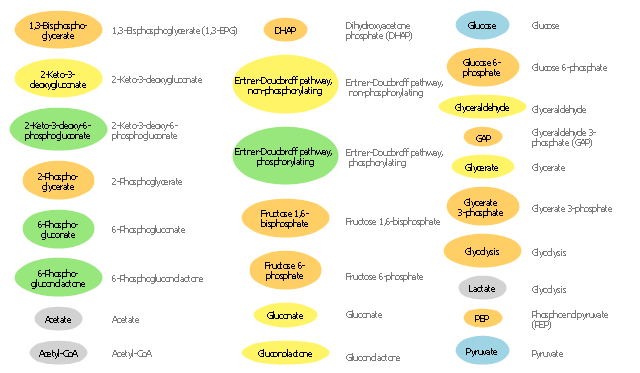This biochemical chart display how proteins, polysaccharides and fats from food are digested into gastrointestinal tract into aminoacids, monosaccharides and fatty acids, and then broken down and oxidized to carbon dioxide and water in cellular processes of energy generation.
This metabolic pathway map was redesigned from Wikipedia file: Catabolism schematic.svg. [en.wikipedia.org/ wiki/ File:Catabolism_ schematic.svg]
The biochemical diagram example "Catabolism schematic" was created using the ConceptDraw PRO diagramming and vector drawing software extended with the Biology solution from the Science and Education area of ConceptDraw Solution Park.
This metabolic pathway map was redesigned from Wikipedia file: Catabolism schematic.svg. [en.wikipedia.org/ wiki/ File:Catabolism_ schematic.svg]
The biochemical diagram example "Catabolism schematic" was created using the ConceptDraw PRO diagramming and vector drawing software extended with the Biology solution from the Science and Education area of ConceptDraw Solution Park.
The vector stencils library "Carbohydrate metabolism" contains 25 icons of metabolite symbols.
Use these shapes for drawing carbohydrate metabolism schematics, biochemical diagrams and metabolic pathways maps.
"Carbohydrates are a superior short-term fuel for organisms because they are simpler to metabolize than fats or those amino acids (components of proteins) that can be used for fuel. In animals, the most important carbohydrate is glucose. The concentration of glucose in the blood is used as the main control for the central metabolic hormone, insulin. Starch, and cellulose in a few organisms (e.g., some animals ... and ... microorganisms), both being glucose polymers, are disassembled during digestion and absorbed as glucose. Some simple carbohydrates have their own enzymatic oxidation pathways, as do only a few of the more complex carbohydrates. The disaccharide lactose, for instance, requires the enzyme lactase to be broken into its monosaccharides components; many animals lack this enzyme in adulthood." [Carbohydrate metabolism. Wikipedia]
The shapes example "Design elements - Carbohydrate metabolism" is included in the Biology solution from the Science and Education area of ConceptDraw Solution Park.
Use these shapes for drawing carbohydrate metabolism schematics, biochemical diagrams and metabolic pathways maps.
"Carbohydrates are a superior short-term fuel for organisms because they are simpler to metabolize than fats or those amino acids (components of proteins) that can be used for fuel. In animals, the most important carbohydrate is glucose. The concentration of glucose in the blood is used as the main control for the central metabolic hormone, insulin. Starch, and cellulose in a few organisms (e.g., some animals ... and ... microorganisms), both being glucose polymers, are disassembled during digestion and absorbed as glucose. Some simple carbohydrates have their own enzymatic oxidation pathways, as do only a few of the more complex carbohydrates. The disaccharide lactose, for instance, requires the enzyme lactase to be broken into its monosaccharides components; many animals lack this enzyme in adulthood." [Carbohydrate metabolism. Wikipedia]
The shapes example "Design elements - Carbohydrate metabolism" is included in the Biology solution from the Science and Education area of ConceptDraw Solution Park.
- Catabolism schematic - Biochemical diagram
- Catabolism schematic - Biochemical diagram | Design elements ...
- Metabolic pathway map - Biochemical diagram | Biology | Network ...
- Schematic Diagram On Metabolism With Different Pathways
- Catabolism schematic - Biochemical diagram | Metabolism Of Fat ...
- Catabolism schematic - Biochemical diagram | Metabolic pathway ...
- Catabolism schematic - Biochemical diagram | Biology | Glucose ...
- Design elements - Biochemistry of metabolism | Metabolic pathway ...
- Diagram To Draw On Biochemistry File
- Catabolism schematic - Biochemical diagram | Catabolism ...
- Simple Schematic Diagram Of Metabolism
- Biology | Catabolism schematic - Biochemical diagram | Design ...
- Flow Chart For Digestion Of Fat
- Catabolism schematic - Biochemical diagram | Biology | Citric acid ...
- Design elements - TCA cycle | Catabolism schematic - Biochemical ...
- Metabolic pathway map - Biochemical diagram | Catabolism ...
- Diagram Of Catabolism Of Proteins Carbohydrates And Fats
- Catabolism schematic - Biochemical diagram | Metabolic pathway ...
- Draw A Diagram Of A Kerbs Cycle
- Glycolysis overview | Catabolism schematic - Biochemical diagram ...

